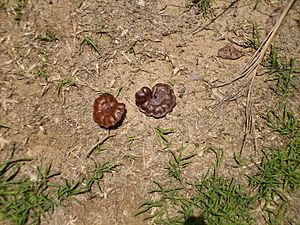Guanacaste facts for kids
Quick facts for kids Guanacaste |
|
|---|---|
 |
|
| A Guanacaste tree in El Canchol, Jalisco, Guanacaste (Costa Rica) | |
| Scientific classification | |
| Kingdom: | |
| (unranked): | |
| (unranked): | |
| (unranked): | |
| Order: | |
| Family: | |
| Genus: |
Enterolobium
|
| Species: |
E. cyclocarpum
|
| Binomial name | |
| Enterolobium cyclocarpum (Jacq.) Griseb.
|
|
| Synonyms | |
|
Several, see text |
|
The Guanacaste tree (scientific name: Enterolobium cyclocarpum) is a large flowering tree. It's also known as the elephant-ear tree because of its unique fruit. This tree belongs to the pea family, called Fabaceae. It grows naturally in warm, tropical parts of the Americas. The Guanacaste tree is very special because it is the national tree of Costa Rica!
Contents
What We Call It
The Guanacaste tree has many names! In English, people often call it the elephant-ear tree. This is because its seed pods look a lot like an elephant's ear. Sometimes it's also called Devil's ear.
In other languages, it has different names:
- In Spanish, it's called guanacaste, árbol de las orejas (tree of ears), or parota.
- In French, it's known as bois tanniste rouge or oreille d'éléphant (elephant ear).
- In German, it's called Affenseife.
The scientific name, Enterolobium cyclocarpum, was given to this plant by a scientist named August Grisebach in 1864. Scientific names help scientists around the world know they are talking about the exact same plant or animal.
About the Guanacaste Tree
The Guanacaste is a very big tree. It can grow to be about 20 to 30 meters (65 to 100 feet) tall. Its trunk can be as wide as 3 meters (10 feet) across! The bark on its trunk is a light gray color. The top part of the tree, called the crown, is very wide and spreads out a lot, giving it a grand look.
Leaves and Flowers
The leaves of the Guanacaste tree are long, usually about 15 to 50 centimeters (6 to 20 inches). They are "compound" leaves, meaning each leaf is made up of many smaller leaflets.
This tree is mostly evergreen, meaning it keeps its leaves all year. However, it might lose its leaves for a short time, about 1 to 2 months, during the dry season. This usually happens in December. But don't worry, new leaves start to grow back in late February, and by April, the tree has a full, green crown again.
The flowers of the Guanacaste tree have both male and female parts (they are "hermaphrodite"). Tiny insects like bees help to pollinate the flowers, which means they help the tree make seeds.
The Unique Fruit
The fruit of the Guanacaste tree is a type of pod, similar to a pea pod. But what makes it special is its shape! It looks just like a human ear, which is why it's also called the "elephant-ear tree."
Where It Grows Naturally
The Guanacaste tree is originally from the tropical parts of America. You can find it growing from southern Mexico, all through Central America, and into northern South America. It also grows in the Caribbean islands. People have also planted it in other warm, tropical places around the world.
It usually grows in areas from sea level up to about 500 meters (1,640 feet) high. You'll often see these trees growing along coastlines and near rivers.
How People Use It
The wood from the Guanacaste tree is a reddish-brown color. It's known for being light and also resistant to water. Because of these qualities, people use its wood for many things. They make doors, windows, and different types of furniture and cabinets. It's also strong enough to be used in shipbuilding. Besides all that, the wood can be used as firewood to create heat.
Images for kids
-
A large Guanacaste tree in Liberia, Costa Rica
-
The Coat of arms of Guanacaste Province
-
An anole lizard climbing a young Guanacaste tree in southern Florida










